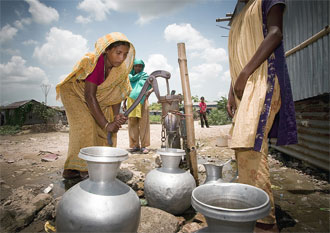Environmental Health at USAID has compiled an annotated bibliography of 21 journal articles on household water treatment and safe storage that were published from January-July 2009.
Link: http://www.ehproject.org/PDF/ehkm/bibliography-hwt_july2009.pdf (pdf, 70KB)
Below are 3 of the 21 studies from the bibliography:
1 – Am J Trop Med Hyg. 2009 May; 80(5):819-23.
Laboratory assessment of a gravity-fed ultra-filtration water treatment device designed for household use in low-income settings.
Clasen T, Naranjo J, Frauchiger D, Gerba C.
Interventions to improve water quality, particularly when deployed at the household level, are an effective means of preventing endemic diarrheal disease, a leading cause of mortality and morbidity in the developing world. We assessed the microbiologic performance of a novel water treatment device designed for household use in low-income settings. The device employs a backwashable hollow fiber ultrafiltration cartridge and is designed to mechanically remove enteric pathogenic bacteria, viruses, and protozoan cysts from drinking water without water pressure or electric power. In laboratory testing through 20,000 L (approximately 110% of design life) at moderate turbidity (15 nephelometric turbidity unit [NTU]), the device achieved log(10) reduction values of 6.9 for Escherichia coli, 4.7 for MS2 coliphage (proxy for enteric pathogenic viruses), and 3.6 for Cryptosporidium oocysts, thus exceeding levels established for microbiological water purifiers. With periodic cleaning and backwashing, the device produced treated water at an average rate of 143 mL/min (8.6 L/hour) (range 293 to 80 mL/min) over the course of the evaluation. If these results are validated in field trials, the deployment of the unit on a wide scale among vulnerable populations may make an important contribution to public health efforts to control intractable waterborne diseases.
4 – Environ Sci Technol. 2009 Feb 15; 43(4):986-92.
Household water treatment in poor populations: is there enough evidence for scaling up now?
Schmidt WP, Cairncross S.
Point-of-use water treatment (household water treatment, HWT) has been advocated as a means to substantially decrease the global burden of diarrhea and to contribute to the Millennium Development Goals. To determine whether HWT should be scaled up now, we reviewed the evidence on acceptability, scalability, adverse effects, and nonhealth benefits as the main criteria to establish how much evidence is needed before scaling up. These aspects are contrasted with the evidence on the effect of HWT on diarrhea. We found that the acceptability and scalability of HWT is still unclear, and that there are substantial barriers making it difficult to identify populations that would benefit most from a potential effect. The nonhealth benefits of HWT are negligible. Health outcome trials suggest that HWT may reduce diarrhea by 30-40%. The problem of bias is discussed. There is evidence that the estimates may be strongly biased. Current evidence does not exclude that the observed diarrhea reductions are largely or entirely due to bias. We conclude that widespread promotion of HWT is premature given the available evidence. Further acceptability studies and large blinded trials or trials with an objective health outcome are needed before HWT can be recommended to policy makers and implementers.
7 – Int J Epidemiol. 2009 Jul 2.
Evaluation of a pre-existing, 3-year household water treatment and handwashing intervention in rural Guatemala.
Arnold B, Arana B, Mäusezahl D, Hubbard A, Colford JM Jr.
BACKGROUND: The promotion of household water treatment and handwashing with soap has led to large reductions in child diarrhoea in randomized efficacy trials. Currently, we know little about the health effectiveness of behaviour-based water and hygiene interventions after the conclusion of intervention activities.
METHODS: We present an extension of previously published design (propensity score matching) and analysis (targeted maximum likelihood estimation) methods to evaluate the behavioural and health impacts of a pre-existing but non-randomized intervention (a 3-year, combined household water treatment and handwashing campaign in rural Guatemala). Six months after the intervention, we conducted a cross-sectional cohort study in 30 villages (15 intervention and 15 control) that included 600 households, and 929 children <5 years of age.
RESULTS: The study design created a sample of intervention and control villages that were comparable across more than 30 potentially confounding characteristics. The intervention led to modest gains in confirmed water treatment behaviour [risk difference = 0.05, 95% confidence interval (CI) 0.02-0.09]. We found, however, no difference between the intervention and control villages in self-reported handwashing behaviour, spot-check hygiene conditions, or the prevalence of child diarrhoea, clinical acute lower respiratory infections or child growth.
CONCLUSIONS: To our knowledge this is the first post-intervention follow-up study of a combined household water treatment and handwashing behaviour change intervention, and the first post-intervention follow-up of either intervention type to include child health measurement. The lack of child health impacts is consistent with unsustained behaviour adoption. Our findings highlight the difficulty of implementing behaviour-based household water treatment and handwashing outside of intensive efficacy trials.





